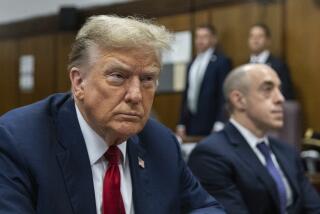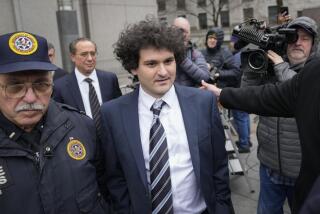Jurors to Hear Fastow Testify
- Share via
After weeks of hearing the name of Andrew S. Fastow -- and never in a flattering context -- jurors in Houston this week finally will get to see the government’s most notorious witness in the federal conspiracy and fraud trial of Enron Corp.’s former top executives, Kenneth L. Lay and Jeffrey K. Skilling.
Fastow, 44, the energy-trading firm’s former chief financial officer and a Skilling protege, has been called a liar and a crook by Lay and Skilling’s lawyers. Legal experts said the defense was looking forward to the opportunity to flay him even further on cross-examination.
Fastow was the whip-smart architect of off-the-books partnerships that the government contends were used to fraudulently conceal Enron debt and amp up reported profit. About the only issue on which defense and prosecution attorneys agree is that Fastow also used the partnerships, which he controlled, to loot millions of dollars from the Enron till.
Enron, once one of the nation’s most-admired companies, collapsed in late 2001 in what was then the largest-ever U.S. bankruptcy filing. Thousands of employees lost their jobs, and many lost the bulk of their life savings as Enron’s once highflying stock became worthless. The implosion touched off a wave of lawsuits, investigations and legal and regulatory reforms.
Under a cooperation deal with federal prosecutors, Fastow pleaded guilty to two conspiracy counts and agreed to forfeit $24 million. He also stands to serve a 10-year prison term.
Nobody thinks Fastow will make a stellar prosecution witness, which is why he hasn’t been placed in the more prominent first or last position.
“They’re burying him in the middle,” said former federal prosecutor Christopher J. Bebel, a Houston defense lawyer in white-collar crime cases. “The government knows most of their gains are going to be wiped away on cross, but they’re hoping they can salvage some points.”
One likely objective is simply “to put Lay and Skilling in bed with Fastow,” said John J. “Jay” Fahy, a Rutherford, N.J., trial lawyer and former prosecutor.
In his opening argument, co-chief prosecutor John C. Hueston -- the former Orange County-based assistant U.S. attorney who will be handling the direct examination of Fastow -- twice referred to him as “the guy down the hall” from Skilling, to emphasize Fastow’s close working relationship with the executive who hired and mentored him.
The prosecution also may use Fastow to add to an impression it has been trying to create in the jurors’ minds, that corruption at Houston-based Enron was a way of life. More than half a dozen former Enron executives have trooped to the stand to testify to their own part in trying to hoodwink Wall Street analysts, fudge accounting numbers and hide looming problems that threatened to devastate the company’s stock price -- the source of much of their wealth. All, to a greater or lesser degree, have implicated either Lay or Skilling in the shell game.
Defense lawyers repeatedly have pointed out that the cooperating witnesses may be motivated by the hope of getting lighter sentences if they can bolster the government’s case. The defense also has pushed most witnesses to admit that they never heard Skilling or Lay tell anyone to break the law or indicate they were aware of wrongdoing.
But Kevin Hannon, former No. 2 executive at Enron’s broadband unit, came closest Thursday when he testified about a May 2001 meeting he attended with Skilling, Lay, Fastow, former Chief Accounting Officer Richard A. Causey and former energy-trading chief Lawrence “Greg” Whalley. The group was discussing an analyst’s report critical of Enron’s reliance on transactions with the Fastow-led partnerships to boost profit and clear underperforming assets off its books.
“They’re on to us,” Skilling said, according to Hannon.
If Fastow corroborates that remark, it could help cement it in jurors’ minds, even if Fastow’s credibility is shredded during cross-examination.
Considering the negative baggage that Fastow carries and the likelihood that he will be subject to devastating cross-examination, why does the government bother to put him on the stand?
The answer, legal experts said, is that the jury expects it. The eight women and four men on the panel already know something about Fastow and are anxious to see him. If the government fails to satisfy their curiosity, they may conclude that the government has something to hide and may choose to believe whatever the defense says about him.
Thus, the government will do what it can to cut its losses. Prosecutors are “going to try to ‘de-demonize’ Fastow a little, but they can’t do it entirely,” said Laura Ariane Miller, a white-collar defense specialist with the firm Nixon Peabody in Washington.
Hannon will return to the witness stand this morning for cross-examination. Fastow is expected to follow, either Tuesday or Wednesday.
Skilling faces 31 counts of fraud, conspiracy, insider trading and lying to auditors. Lay faces seven counts of fraud and conspiracy.
Both sold millions of dollars in stock before Enron failed, but only Skilling is charged with improper stock sales. If convicted, they could face decades in prison.
The Associated Press was used in compiling this report.
More to Read
Sign up for Essential California
The most important California stories and recommendations in your inbox every morning.
You may occasionally receive promotional content from the Los Angeles Times.










